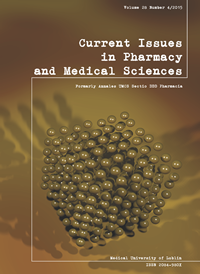Do you know what you eat? Students of the Medical University of Lublin and food consumption awareness
DOI:
https://doi.org/10.1515/cipms-2015-0085Słowa kluczowe:
modified food, organic products, young peopleAbstrakt
At the present time, consumers are paying more attention to the food items they purchase, and, hence, organic products, more and more, are a popular choice. Furthermore, there is an increased awareness of the ingredients added as fixatives and taste modifiers. Medical students are assumed to have greater health awareness, and to recognize that proper nutrition has a significant impact on the overall physical well-being. Moreover, they are thought to be aware of the chemical composition of consumed foods. The aim of our study was to truly assess the degree of consumer awareness amongst students of the Medical University of Lublin.
The research study consisted of 301 students of the I and II years, the work being performed at the turn of the year 2014/2015. The research tool was an anonymous questionnaire. This contained questions regarding their degree of healthy food awareness of retailed food products.
The results of this study revealed that about 44% of the respondents always or often pay attention to the composition of the food products which they buy. Indeed, the highest percentage of all respondents declared that their purchase of food products is guided by the declared (labeled) composition (48.84% of the students coming from urban settings, and 55.81% coming from rural districts). Of note, regarding products labeled organic, from both urban and rural origin, such items were chosen by approximately 50% of the respondents. Finally, only a small percentage of students (about 9% overall) stated that they avoid foods stated to contain preservatives.
In summary, despite the increasing availability of healthy foods, such items are not too often chosen by UM students - Indeed, despite the large biomedical knowledge purportedly held, medical students, in particular, do not avoid foods containing preservatives.
Bibliografia
1. Antoniak L., Danowska-Oziewicz M.: Knowledge and opinions of students on additives used in food production. Pol. J. Natur. Sc., 29(3). 2014.
2. Bywalec C. (2010). Konsumpcja a rozwój gospodarczy i społeczny. In: Ekonomia. Perzyńska J. (editor). Warszawa: p.12.
3. Gadomska J., Sadowski T., Buczkowska M.: Ekologiczna żywność jako czynnik sprzyjający zdrowiu. Probl Hig Epidemiol., 95(3), 2014.
4. Grzelak A., Gałązka M.: Związki potrzeb, popytu i konsumpcji żywności- ujęcie teoretyczne. http://www.kpsw.edu.pl/pobierz/wydawnictwo/re4/37_grzelak_galazka.pdf (available: 20.08.2015).
5. Grzybowska-Brzezińska M.: Świadomość ekologiczna konsumentów a ich zachowania na rynku żywności. Studies & Proceedings of Polish Association for Knowledge Management, 51, 2011.
6. Koreleska E., Pirogowska E.: Źródła informacji oraz wiedza mieszkańców Bydgoszczy na temat żywności ekologicznej. POLSKIE STOWARZYSZENIE ZARZĄDZANIA WIEDZĄ Seria: Studia i Materiały, 66, 2013.
7. Kowalczuk-Vasilev E., Klebaniuk R., Gronowicz K.: Żywność ekologiczna w opinii studentów różnych lat studiów uczelni lubelskich. Probl Hig Epidemiol., 92(4), 2011.
8. Krejpcio Z., Suliburska J., Hyżyk A.H., Dyba S., Skwarek K.: Ocena poziomu wiedzy na temat dodatków do żywności oraz ich spożycia w wybranych grupach studentów. Bromat. Chem. Toksykol., XLIV, 3, 2011.
9. Krełowska-Kułas M.: Preferencje konsumentów związane ze spożywaniem żywności ekologicznej. Zeszyty Naukowe Akademii Ekonomicznej w Krakowie, 743, 2007.
10. Niewczas M.: Kryteria wyboru żywności. ŻYWNOŚĆ. Nauka. Technologia. Jakość, 6 (91), 2013.
Pobrania
Opublikowane
Numer
Dział
Licencja
Prawa autorskie (c) 2015 Autorzy

Praca jest udostępniana na licencji Creative Commons Attribution-NonCommercial-NoDerivatives 3.0 Unported License.


